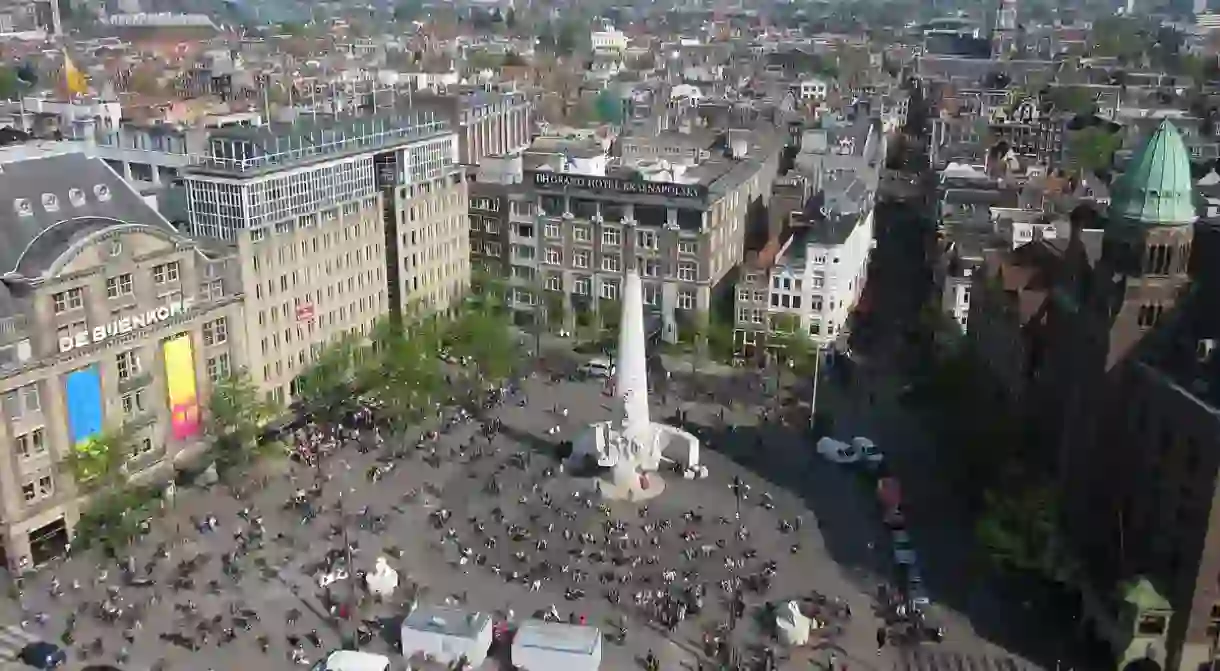10 Monuments You Need To Visit in Central Amsterdam

Amsterdam’s city centre is brimming with history and exploring its winding, narrow streets or 17th-century canal belt allows visitors to glimpse into its tremendous past. Several impressive monuments are scattered throughout its central districts, which commemorate significant aspects of Dutch heritage while paying tribute to important events from European history.
The National Monument
The National Monument was constructed on Dam Square in 1952 and looks directly onto the Royal Palace. The base of this white, stone obelisk is supported by several statues that represent members of the Dutch resistance. A sculpture of a woman, holding a child is located above these male figures, which symbolises peace and victory. The monument was designed to commemorate World World II and other subsequent armed conflicts.

Homomonument
After years of campaigning and development the Homomonument was unveiled in 1987. This large, pink triangle was the first memorial in the world dedicated to the LGBTQ individuals that were murdered during the Holocaust and was designed to draw attention to the ongoing and historical struggles faced by LGBTQ people. During days of remembrance and celebrations, such as Pride or Liberation Day, memorial activities take place around the Homomonument.
📍 Homomonument, Westermarkt, Amsterdam

Anne Frank House
During World War II Anne Frank and her family hid from the Nazis inside a concealed apartment in de Jordaan. Eventually, they were discovered by the occupying force and Anne and her sister were departed to Auschwitz concentration camp where they would later die. Today, visitors to Amsterdam can pay their respects to Anne Frank and her family at a museum that is located inside their former sanctuary.
📍 Anne Frank House, Prinsengracht 263-267, Amsterdam +31 20 556 7105

Ons’ Lieve Heer op Solder
After the Netherlands officially converted to Protestantism in the 16th century, the Dutch government outlawed Catholicism to ensure that the papal states couldn’t reclaim dominion over the country. This meant that the remaining Dutch Catholics were forced underground and began practising their faith in secret. During this period several concealed churches were constructed around Amsterdam, including Ons’ Lieve Heer op Solder, which was built inside the attic of a townhouse. Miraculously this small, ornately decorated chapel is still intact and has been converted into a wonderful museum.
📍 Museum Ons’ Lieve Heer op Solder, Oudezijds Voorburgwal 38, Amsterdam, +31 20 624 6604

The Portuguese Synagogue
In the 17th century, Amsterdam became a haven for Jewish people fleeing from the Spanish and Portuguese inquisition. Many Jewish refugees travelled to Amsterdam as it was among first cities in Europe to permit religious freedom. Eventually, these immigrants grew wealthy and decided to build an enormous synagogue near Jodenbreestraat, that remains an important place of worship for Amsterdam’s Jewish community.
📍 The Portuguese Synagogue, Mr. Visserplein 3, Amsterdam, +31 20 624 5351

Hollandse Schouwburg
After invading Amsterdam, the Nazis ghettoised the city’s main Jewish neighbourhood and turned its theatre into a transportation centre where people were round up and sent to transit camps on the Dutch-German border. Most of these people were eventually murdered, and today the theatre has been converted into a holocaust memorial.
📍 Hollandse Schouwburg, Plantage Middenlaan 24, Amsterdam, +31 20 531 0310

The Royal Palace Amsterdam
Although now called the Royal Palace, the magnificent building on the western side of Dam Square was originally owned by the city’s council and served as their headquarters. This palatial structure was built in 1655 to reflect Amsterdam’s booming economic and cultural influence. Eventually, it fell into the hands of the Dutch Royal family, who now use it for ceremonial purposes. However, the Royal Palace is open to the public and regularly hosts historically orientated exhibitions.
📍 The Royal Palace Amsterdam, Dam, Amsterdam, +31 20 522 6161

The Oude Kerk
Disregarding renovations and reconstruction projects, The Oude Kerk has been standing in central Amsterdam for almost 1000 years, making it the oldest building in the city. The church was originally Catholic, but was taken over by Protestants during the Reformation. Although the church has been significantly altered throughout the years, its wooden ceiling has remained intact since 1390 and is among the most impressive structures of its type in the world.
📍 The Oude Kerk, Oudekerksplein 23, Amsterdam, +31 20 625 8284

Oudekerksplein
Ouderkerksplein is in the centre of Amsterdam’s red light district and is surrounded by hundreds of prostitution windows. During February 1993, an anonymous artist added a small, bronze relief to the square that depicts a hand resting on a pair of naked breasts. Although its meaning remains undisclosed, the statue is commonly believed to memorialise the city’s sex workers. In 2007 another statue, called Belle, was placed on the square and clearly portrays the area’s prostitutes. The sculpture is the only official monument in the world that is dedicated to sex workers.

Magere Brug
Although Magere Brug is actually a relatively new addition to Amsterdam’s waterway, it is already considered iconic. The bridge is extremely photogenic and has appeared in several movies due to its picturesque nature. It is also one of the most romantic spots in Amsterdam and couples can often be seen walking hand in hand between its white masts.














